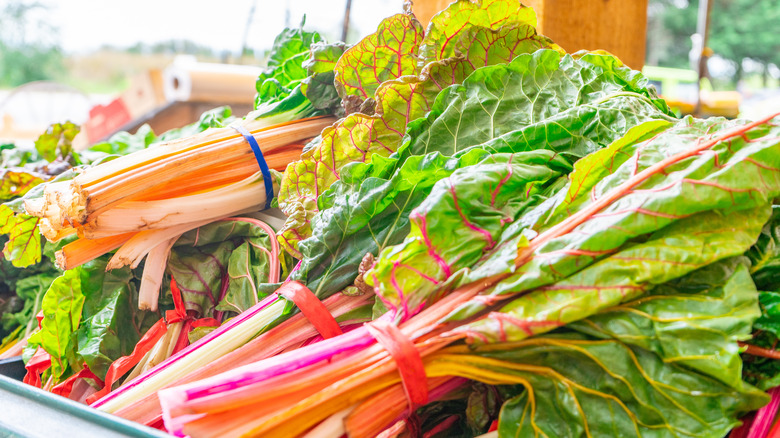Why You Should Try Swiss Chard If You Don't Like Kale
Over the years, kale has proudly worn its crown as the king of leafy greens. This powerful veggie shows up in recipes, smoothies, juices — you name it. Even fast-food chains such as McDonalds and Chick-fil-A are waving goodbye to iceberg lettuce for their salads (per Stack). While nobody can deny it's chockfull of health benefits, not everyone loves kale as it can be quite bitter and tough. Luckily, there's another leafy green superfood to choose from called Swiss chard.
U.S. News & World Report points out one serving of kale has 36 calories, 3 grams of fiber, 2 grams of protein, 9% of the recommended daily amounts (RDA) for calcium, and 6% RDA for iron. On the other hand, Swiss chard has 35 calories, 4 grams of fiber, 3 grams of protein, 10% RDA for calcium, and contains more than double the RDA of iron at 22% (via U.S. News & World Reports). It also contains 1,038% of the RDA of vitamin K which exceeds kale's 1,021%.
The benefits of Swiss chard and how to eat more
Getting more vitamin K from this vegetable may do wonders for your overall health. Eat This, Not That shows vitamin K is especially helpful for managing diabetes, heart health, and bone health. "Your body uses vitamin K to make proteins that are important for blood clotting, maintaining bone health, and preventing calcium deposits in soft tissues, such as your arteries, kidneys, and elsewhere," Melissa Groves, registered dietitian and founder of Avocado Grove Nutrition & Wellness, told Eat This, Not That.
Medical News Today points out Swiss chard is also high in vitamin C, A, E, potassium, magnesium, folate and phosphorus. Studies have shown its high nutritional content helps with a variety of health conditions. Other benefits were lowering blood pressure, preventing cancer and osteoporosis, and increasing athletic performance.
Thus switching out kale and incorporating more Swiss chard is a great way to rotate your leafy greens and give your body different nutrients it may need. Swiss chard is more mild and palatable than kale, so it's easy to use. Cut the stems and leaves to make a salad, add it into scrambled eggs, toss them into a smoothie, or sauté them with olive oil for a warm salad.


